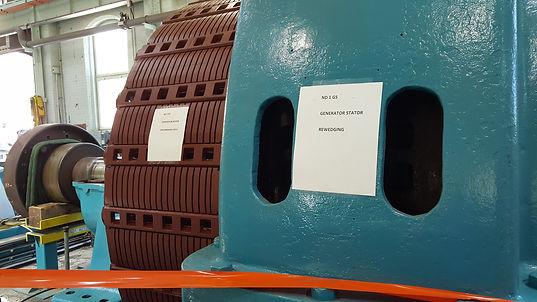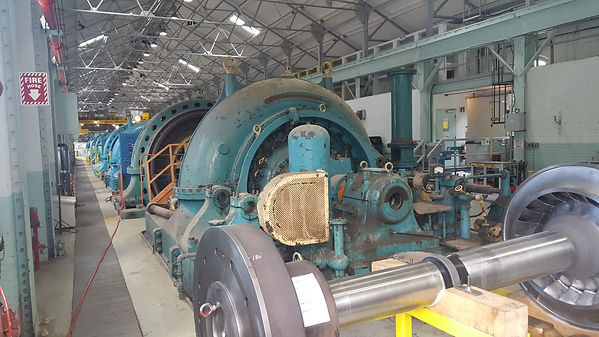EMPOWER
By Lilly Otasevic
The remarkable transformation of Hamilton into the industrialized, multicultural city it is today would never have happened without the hydrological force of nature, the entrepreneurial vision of the ‘Five Johns’ and the genius of the inventor Nikola Tesla.
Empower draws inspiration from both nature and the inquiring human mind. An interactive sculpture, it incorporates a lenticular effect: two images coexist within, inhabiting the same space and time but are never fully revealed simultaneously.
The main ribbed elements resemble the fluid dynamics of water or a waterfall. Deeper within the sculpture, a second form resides: a stylized DeCew Falls power plant turbine that is only revealed to the eye of the viewer at opportune angles.
Within the vast atomic domain
Every living creature
Is part of the brain,
Of the wheelwork of Nature.
To unlock the notions
Of the depths of existence,
All energy vibrations
Join in life’s transmittance.
The power of the mind, thus,
Is only as great
As Nature empowers us
With curiosity – to innovate.
Lilly Otasevic, November 2023
Hamilton, Ontario
Get Inspired by EMPOWER

Trkulja, Michelle Portrait of Nikola Tesla, 2016, Hamilton, Ontario
Nikola Tesla & the Electric City
Nikola Tesla, a brilliant young Serbian-American inventor, received his first patent for the alternating current (AC) induction motor with seven more patents for the complete alternating current polyphase system of motors, generators and transformers in 1888. This series of patents made it possible to transmit electric power over great distances with minimal loss.
Two ingenious inventions revolutionized industry,
first in North America and then the world: the rotating
magnetic field and the induction motor. Both were
powered by alternating electric current and both were
patented by Nikola Tesla.
HAMILTON THE ELECTRIC CITY
George Westinghouse, founder of Westinghouse Electric, purchased the complete series of Tesla’s AC system patents. In 1893, the contract for the Edward Dean Adams Power Generating Station at Niagara Falls, New York, was awarded to Westinghouse. This drew the attention of John Patterson, Hamilton entrepreneur and one of the ‘Five Johns,’ who had formed a private power utility: the Cataract Power Company. He visited the station in 1894 and the group, undeterred by the Americans refusal to sell power and monopoly of water rights at Niagara Falls, decided to build their own plant. The site was near DeCew Falls and the Welland Canal in St. Catharines, Ontario, provided the water source. This was 56 km away from Hamilton; a seemingly insurmountable distance to transmit electricity.
Cataract consulted Nikola Tesla with their plans and he approved, confirming that they could transmit power over that distance. Thus, the DeCew I Power Generating Station was built and power first transmitted on August 25, 1898, to the Cataract Power Building in Hamilton: making history as the second longest power transmission line in the world at the time.
Our modern lifestyle of comfort and convenience would not be possible without Tesla’s inventions, which are now an integral part in our homes, offices, factories, public transit systems, medical, agricultural, military and space programs. Conceived in the late 19th century, Tesla’s legacy lives on in the 21st century and continues to play a vital and inseparable part in contemporary life.
‘The progressive development of man is vitally dependent on inventions. It is the most important product of his creative brain. Its ultimate purpose is the complete mastery of mind over the material world, the harnessing of the forces of nature to human needs. Electric power is everywhere present in unlimited quantities and can drive the world's machinery without the need of coal, oil, gas, or any other of the common fuels. Let the future tell the truth and evaluate each one according to his work and accomplishments. The present is theirs; the future, for which I really worked, is mine.’
Nikola Tesla
The DeCew I Power Generating Station operated by channeling water from the Welland Canal into reservoirs on the Niagara Escarpment, then funneling the water down massive penstocks into turbines at the Escarpment base. Two transmission lines carried high voltage power overhead across farmers’ fields, one of which came down the Escarpment at Kings Forest. Power was transmitted over a 56 kilometre line to their Victoria Avenue North station in Hamilton. From the station, power was distributed to customers, including the City, major industries, the Hamilton Street Railway and several interurban railways.
The arrival of cheap hydroelectric power propelled the rapid economic development of Hamilton, Ontario. George Westinghouse was one of the first to recognize its potential, building a large factory in the City in 1897. Westinghouse Electric soon became the leading manufacturer of electrical turbines, transformers and electrical appliances and naturally, established its Canadian headquarters in Hamilton.
Already a major industrial city on the Great Lakes, the new electrical infrastructure supported a substantial expansion of the City’s industrial area, securing Hamilton’s place as an industrial leader in the 20th century. It prompted electrical workers to form the Electrical Workers Union ensuring safer working conditions and attracted thousands of new immigrants to work in Hamilton’s factories. Newcomers settled in the neighbourhoods built around the factories and the City transformed into a multi-cultural centre.
Image: Cataract Power Station on Victoria Avenue North in Hamilton, Ontario
Globally recognized as the ‘Electric City of Canada,’ Hamilton had the cheapest, most reliable power in Canada, if not the world. Though industry was the first to benefit from this electrical infrastructure, it was not long before these benefits were available to all. Following the establishment of the Hydro Electric Power Commission of Ontario (HEPCO) in 1906, the citizens of Hamilton voted to fund a municipal system that would distribute power to every household in the City at a reasonable rate. On July 1, 1914, founder of HEPCO, Sir Adam Beck flipped the switch for the city’s new street lighting system. Hamilton Hydro trumpeted its benefits: ‘Hydro-electric is the People’s Project and every citizen is financially interested… the more customers, the lower the rates.’
Cataract continued to serve many of the City’s industries until 1930, when they sold their assets. Local assets were acquired by Hamilton Hydro while the DeCew Station was acquired by Ontario Hydro. The DeCew Station remains in operation today the longest operating AC hydro-electric stations in Canada. Once a frightening and thrilling new technology, electricity swiftly became an essential service that transformed life in the 20th century. It continues to shape our lives through innovation in the 21st century.
HAMILTON THE ELECTRIC CITY: EXPANDING THE NARRATIVE
Hamilton began to promote itself as ‘The Electric City’ and new industry brought employment and wealth to many, growing a diverse workforce and the city in the process. The rapid expansion also presented many challenges in an era without legislated environmental protection. The shoreline in the east end of the city was transformed as the natural inlets and marshes were infilled and developed. The health of both the land and water as well as fish, waterfowl and animals were dramatically impacted. These inlets and waters formed part of in important food network for the Atirhaguenrek (Attawondaron /Neutral) Haudenosaunee (Six Nations) and Mississauga since time immemorial as well as settlers and newcomers to the region and the shoreline changes further reduced access to wild food sources. Eventually, the entire waterfront would become an industrial landscape.



DeCew I Power Generating station
under construction 1897-1898






DeCew I Power Generationg Station 125 + Years of Power

There may be no better way to communicate what we do than through images. As you browse our site, take a few moments to let your eyes linger here, and see if you can get a feel for our signature touch.





















Come Back to see more





